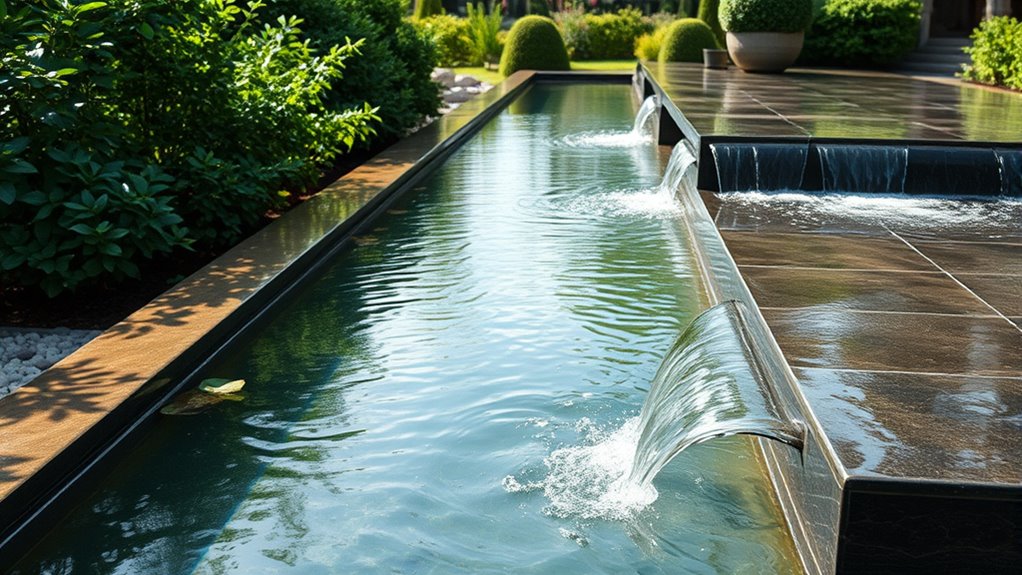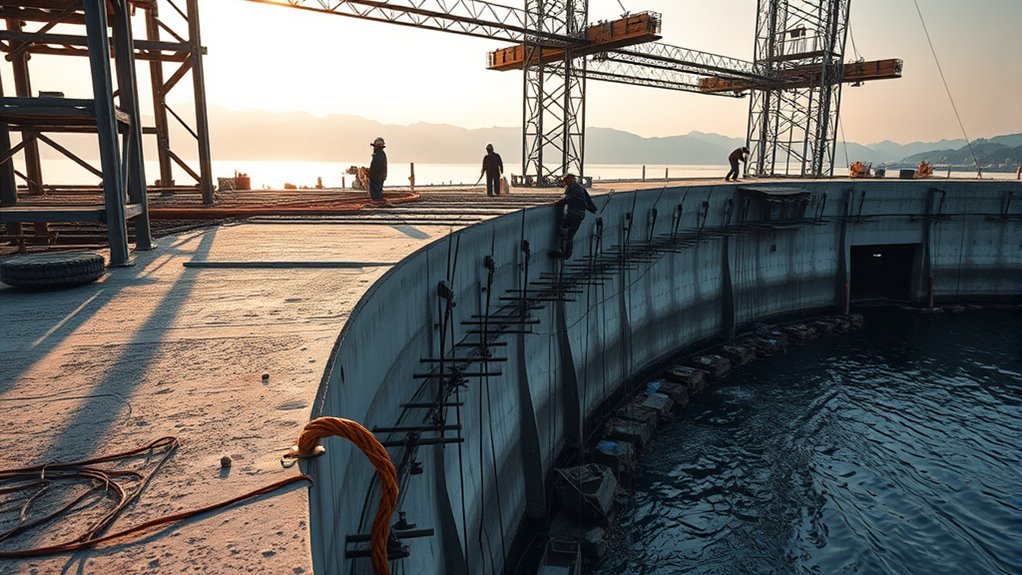To build a vanishing edge and weir, start by designing your water feature, choosing the right location, materials, and layout. Then, create a sturdy base using concrete or gravel, and build a waterproof framework inside. Install a waterproof liner, then carefully set the vanishing edge—using glass or stone—ensuring it’s level and sealed. Connect the weir with your pump and filtration system, and tweak the flow for seamless water extension. Keep exploring to master every step.
Key Takeaways
- Design the vanishing edge with level, waterproof materials like glass or custom stone, ensuring proper sealing and slight slope for water flow.
- Construct a sturdy framework using waterproof materials, then install a waterproof liner to prevent leaks.
- Position the weir at the designed location, connecting it to the pump and filtration system for smooth water circulation.
- Test and adjust water flow, level, and rate to achieve the desired aesthetic and functional performance.
- Finalize with landscaping and aesthetic details to seamlessly integrate the vanishing edge and weir into the landscape.
Planning and Designing Your Water Feature

Before you begin building the vanishing edge and weir, it’s vital to plan and design your water feature carefully. Start by visualizing how you want it to look and function in your space. Consider the size, shape, and flow of the water, making sure it complements your landscape. Decide on the location, keeping in mind sunlight, accessibility, and drainage. Sketch out your ideas, marking where the edge and weir will go. Think about the materials you’ll need, like concrete, glass, or stone, and how they’ll blend with your environment. Remember to plan for essential components like pumps and filtration. Proper planning now helps prevent costly mistakes later and guarantees your water feature is both beautiful and functional. Maximize space and organization by creating designated zones for different aspects of your water feature to streamline construction and maintenance.
Constructing the Base and Framework

With your design plans in place, you can now begin constructing the base and framework that will support your water feature. Start by creating a sturdy foundation that can handle the weight and movement of water. Proper support assures longevity and stability.
Here are key steps to follow:
- Lay the foundation with a concrete slab or compacted gravel to provide a level, durable surface.
- Build the framework using waterproof materials like pressure-treated wood or steel for the structure’s walls and supports.
- Install a waterproof liner within the framework to prevent leaks and protect the structure from water damage.
Focusing on these steps guarantees a solid base, making the rest of your project easier and more reliable.
Frequently Asked Questions
What Safety Precautions Are Essential During Installation?
You should wear safety gear like gloves, goggles, and a hard hat to protect yourself during installation. Make sure the area is clear of debris and secure all equipment properly. Use caution when handling heavy materials and working at heights, and follow manufacturer instructions closely. Always have a spotter or colleague nearby to assist and ensure you’re aware of your surroundings to prevent accidents. Safety first, every time.
How Do I Maintain the Water Level Regularly?
To maintain the water level regularly, you should check it daily, especially during hot or windy days. Use a reliable water level indicator or a transparent sight glass to monitor fluctuations. Top off the water as needed with a clean, water-compatible additive if required to prevent algae growth. Keep an eye out for leaks or blockages in the system, and adjust the flow rate to ensure a consistent edge appearance.
Can I Customize the Water Flow for Different Effects?
Absolutely, you can customize the water flow for different effects, turning your pond into a symphony of movement. Think of your water as a painter’s palette—adjusting valves and pumps lets you craft gentle ripples or dramatic cascades. With a little tinkering, you’re the maestro, directing the water’s dance. Experiment with flow rates and valve settings to achieve the mesmerizing effect you envision, creating a dynamic, living masterpiece in your landscape.
What Materials Are Best for Long-Term Durability?
You should choose high-quality, durable materials like stainless steel or marine-grade aluminum for long-term durability. These metals resist corrosion and can withstand constant water exposure, making them ideal for vanishing edges and weirs. Additionally, using tempered glass or acrylic panels with strong framing guarantees longevity. Regular maintenance and proper sealing will further extend the lifespan of your water features, keeping them looking great for years.
How Do I Troubleshoot Common Issues With the Vanishing Edge?
Imagine you’re in the midst of a ’90s tech boom—troubleshooting your vanishing edge is just like fixing an old dial-up connection. First, check for uneven water levels, as they cause splashes or a weak edge. Inspect the weir for blockages or debris that disrupt flow. Make certain the pump is functioning properly and filters are clean. Regular maintenance keeps your edge seamless and prevents unexpected hiccups.
Conclusion
As you complete your vanishing edge and weir, remember that your creation isn’t just water and stone—it’s a reflection of your vision and patience. Like a guiding river, your design symbolizes tranquility and flow, reminding you that beauty emerges from careful planning and effort. With each ripple, you’ve shaped a space where serenity resides, turning a simple water feature into a timeless symbol of harmony and craftsmanship.









